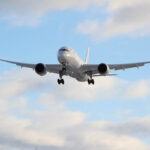Cockroaches are a common household pest, and while many people are familiar with their scurrying habits, the question “Which Cockroaches Fly?” often arises. It might be surprising to learn that numerous cockroach species are indeed capable of flight, or at least gliding, using their wings to navigate their environment and sometimes, unfortunately, invade our homes. Understanding which cockroaches possess this ability is crucial for effective pest management.
Common Cockroach Species Known for Flying
Several types of cockroaches are known for their flying or gliding capabilities. These species utilize their wings to varying degrees, some being adept fliers while others prefer to glide.
- Asian Cockroaches: Often mistaken for German cockroaches due to their similar appearance, Asian cockroaches are strong fliers. They are commonly found in warmer climates like Florida and are frequently attracted to lights.
- Brown Cockroaches: This is a broad category, but some brown cockroach species, like the Smokybrown cockroach, are excellent fliers. Smokybrown cockroaches, in particular, are large and known to fly readily, especially in warmer regions of the United States.
- Wood Roaches (Florida Woods Cockroaches): As their name suggests, these cockroaches are often found in wooded areas. They are also capable fliers and may be attracted to homes, especially in areas bordering forests or with ample vegetation.
- American Cockroaches: While perhaps more accurately described as gliders, American cockroaches, one of the largest house-infesting roaches, do use their wings to glide, particularly when moving from high places to lower ones. They are less likely to engage in sustained flight but can cover considerable distances by gliding.
- Australian Cockroaches: Prevalent in warmer coastal regions, particularly the Gulf Coast, Australian cockroaches are also capable fliers. They share similarities with American cockroaches but are generally smaller and known to fly more readily.
- Cuban Cockroaches: Distinctive for their bright green color, Cuban cockroaches are also known to fly. They are less common household pests compared to others listed but are found in warmer areas and are capable of flight.
Cockroaches Less Likely to Take Flight
In contrast to the above, some common cockroach species are not known for flying:
- German Cockroaches: The most common cockroach found in homes worldwide, German cockroaches are not capable of flight. They possess wings, but they are primarily used for protection and are not functional for flying.
- Oriental Cockroaches: Also known as “waterbugs” or “black beetle cockroaches,” Oriental cockroaches are another species that does not fly. Their wings are underdeveloped in females and cover only part of the abdomen in males, rendering them flightless.
Why Flying Cockroaches Become a Problem Indoors
Flying cockroaches can become a nuisance in homes for several reasons. Their ability to fly allows them to easily access different parts of a house, spreading infestations more rapidly than non-flying species.
One primary reason flying cockroaches enter homes is their attraction to light. Like many nocturnal insects, they are drawn to artificial lights emanating from windows and doors, especially at night. This can lead them to fly directly into homes through open windows, doors, or even small gaps.
Furthermore, cockroaches, including flying varieties, are constantly in search of food and water. Our homes provide ample sources of both. Kitchens and pantries, in particular, offer readily available food sources, while bathrooms and areas with leaks provide moisture. Flying ability expands their reach to find these resources throughout a house.
Problems Associated with Flying Cockroaches
The presence of flying cockroaches in a home can lead to several issues:
- Increased Spread: Their flight capability allows them to disperse quickly throughout a building, infesting multiple rooms and levels.
- Contamination: Cockroaches are known carriers of bacteria, pathogens, and allergens. When they fly and land on countertops, food preparation surfaces, and stored food, they can contaminate these areas, posing health risks.
- Difficult to Reach: Flying cockroaches can access high places and hard-to-reach areas, making them more challenging to control with standard pest control methods.
- Allergies and Health Risks: Cockroach allergens, found in their droppings, shed skins, and saliva, can trigger allergies and asthma, especially in sensitive individuals. Furthermore, cockroaches can transmit diseases like salmonellosis, dysentery, and gastroenteritis through food contamination.
Preventing and Managing Flying Cockroach Infestations
Preventing flying cockroach infestations involves several strategies:
- Seal Entry Points: Caulk cracks and crevices around windows, doors, pipes, and foundations to prevent entry.
- Screen Windows and Doors: Ensure window and door screens are in good repair to keep flying insects out.
- Reduce Outdoor Lighting: Minimize the use of bright outdoor lights, especially near entry points, as these can attract flying cockroaches.
- Maintain Cleanliness: Regularly clean kitchens and pantries to eliminate food debris and spills. Store food in airtight containers.
- Control Moisture: Fix leaky pipes and faucets to reduce water sources that attract cockroaches. Ensure proper ventilation in damp areas like bathrooms and basements.
- Professional Pest Control: For existing infestations, especially those involving flying cockroaches, professional pest control services are often the most effective solution. Pest control experts can identify the species, locate nesting sites, and implement targeted treatments to eliminate the infestation and prevent future problems.
In conclusion, while not all cockroaches fly, several common species are capable of flight or gliding, which can exacerbate pest problems in homes. Understanding which cockroaches fly and taking preventative measures are key steps in managing these unwanted pests and maintaining a healthy home environment.
